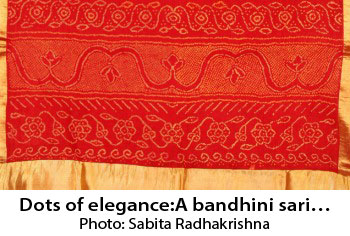Bewitching bandhini

Gaze at peacocks dancing in abandon among a garden of flowers, joined by dancers doing the dandiya ras. Instruments are being played, the occasional animal is silent spectator. No video or painting this, but motifs captured in fine outlines of miniscule, light coloured dots on textile, against a vivid red background. Imagination runs riot laced with the brilliance of colours as the craftspeople work on the textiles. This, then, is the captivating craft of bandhini which involves dyeing after the fabric is tied according to a planned pattern.
One cannot ascertain as to when the tie and dye craft originated in Gujarat. It is conjectured, judging from the small fragments of silk discovered in the medieval period, that Jain monks used the silk to protect their manuscripts and paintings. Tie-dye may have been introduced from Sind or /and Multan area, and the bandhini technique transferred to Gujarat by communities of craftsmen who migrated from Sind, most likely in the 16th century. Jamnagar was one of the earliest dyeing centres for bandhini in Gujarat as the water brings out the intensity of colour in the dye. Very intricate designs are done in Kutch, and sent to Jamnagar for dyeing and marketing. The Khatri community of textile craftsmen, both Hindus and Muslims, have been producing bandhini since the 17th century.
Jabbar Khatri's great grandfather switched careers to make fire crackers for the Royal family of Kutch. After a three generation gap, Jabbar's brother Abdullah took up bandhini once more and Jabbar followed suit. There is hope when young educated men like him return to traditional craft in preference to mainstream jobs and a new career. Working with the National Institute of Design in Ahmedabad at a natural dyeing workshop reinforced his conviction that his traditional craft could be given a contemporary twist by using new designs, different colours and dyeing techniques.
Bhuj and Kutch follow a complicated process. The fabric is bleached and folded precisely into several layers, and fixed by stitching the borders of the folded fabric. The rangari or colour-specialist, marks the design on the topmost layer. Using a mixture of burnt sienna and water, smeared on a cord, he draws lines with the cord to mark the field of design. Then he stamps the design, using wooden blocks dipped into the same colour. Next he chooses the portions of the fabric which have to preserve the ground colour of the fabric. These small portions are pushed up with a pointed nail. The projected portions are bound with string and the same process is repeated from one dot to the other. It is only the women and girls who carry out this delicate art of tying as it is a skill very rarely exhibited by men. The first colour dyed is a light colour, usually yellow. The portions which need to remain yellow, are again tied and the fabric dyed in a darker colour. The tie-and-dye process is repeated for as many colours as are required. This technique is applied to the sari borders as also the pallu. With the present-day cold dyes and plastic foil easily available for wraps, the process is somewhat simplified, but the fact remains that it is a handcraft which makes the effect so breathtakingly beautiful. Bandhini fabric is often sold without the tied thread removed, and today the crinkled effect is in vogue.
The more gossamer the fabric the better the design shows off. Georgettes, mulls, kotas and light silk do best with bandhini. Of course heavier silks are also used, like satins and gajji silks, but they are more difficult to work with. Bandhini is worked on odhnis, turban material, shawls, and fabric for contemporary garments like skirts, tops and kurtas.
Like many of the age-old textiles, bandini has a socio-religious significance. The Gharchola or the zari chowkda, gifted to the bride by her in-laws, mostly in the Marwari and Jain community, either in cotton or in gajji silk, is a traditional wedding sari in bright red with thick zari checks in seven patterns of bandhini enclosed in the squares. The bride wears this over her head during the wedding rites. The vira bhet bhat, the brother's offering, is distinctive for its ceremonial significance.
The rosamandal design on odhnis and saris shows women dancing in a circle and done in Kutch. The red and black tie-and-dye odhni with a central moon-shaped jewel was known as chanderkhani.. The Khoja community produced interlaced circular designs as also the leharia designs, which brought in the bandhini in waves or zigzag patterns.

The Kutch bandhini workers tie multiple designs in squares of parrots, elephants, birds, lotuses, jewels, women, etc. and add the green colour where required. The bavanbagh which is literally “52 gardens” usually has the ties in green and red with diagonal squares containing different motifs in each square like the chakli chaklo, hathi or elephant, puthli or doll, mor or peacock, popat or parrot, pachak (5 circles) panihari (figure carrying a pot), leher or wave and kharek (as in grapes). Some of the upper classes enhance the work further with gota, other borders stitched on, and embroidery.
Now that traditional craft has taken on a contemporary slant, and the demand quite high, we can heave a sigh of relief that this exquisite craft of tying and dyeing will be perpetuated for many years to come.
Crafts Council of India's exhibition KAMALA, a classic textile craft revival will showcase A. Jabbar Khatri's signature bandhini creations along with reproductions of some of the finest heritage saris on December 16th and 17th 2010 at the Lalit Kala Akademi.
www.craftscouncilofindia.org Sabita Radhakrishna is a Chennai based freelance writer in craft and textiles and may be contacted at kittsasbi@dataone.in
Turning to tradition
A. Jabbar Khatri was born into a family of Khatris. After graduating in commerce Jabbar decided to make bandhini craft his profession, acquiring the skill from his mother and brother.
This was quite an unusual step for a young educated man of his age when most of his peers were leaving traditional craft to work in mainstream jobs. Today, Jabbar works with India's leading designers and his bandhini products were presented on the ramp in the Lakme Fashion Week in 2007 and 2008, in the Australia fashion week, and in Wills Fashion Show in 2010 in Delhi. Jabbar has participated in the Folk Art Market at Santa Fe and has been invited by Warwick University for demonstration of his craft at Victoria and Albert Museum in London. He is also working with DOSA, a designer company for the last 7 years in USA. Jabbar Khatri was awarded SEAL of Excellence for the craft of bandhini by UNESCO in 2006,2007 and 2008.
Sabita Radhakrishna is a Chennai based freelance writer in craft and textiles and may be contacted at kittsasbi@dataone.in

